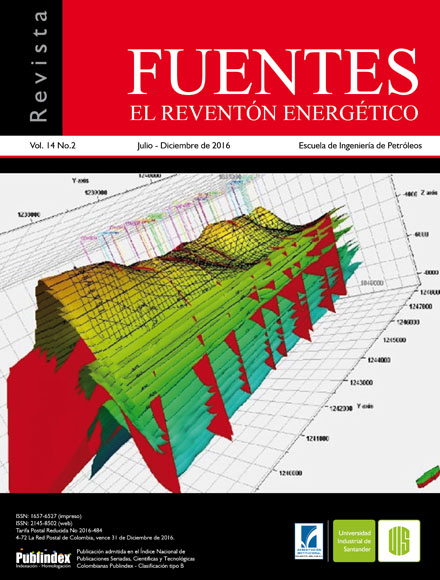Proxy Models, an alternative to reduce the computational time during numerical reservoir simulation
Published 2017-01-27
Keywords
- Numerical Reservoir Simulation,
- Proxy Model,
- CO2 injection
How to Cite
Copyright (c) 2016 Fuentes, el reventón energético

This work is licensed under a Creative Commons Attribution 4.0 International License.
Abstract
The reservoir simulation is a tool which had been evolving at the same time than the petroleum industry; its main purpose is to predict the behavior of a reservoir and afterward finding the optimum scenario in order to increase the oil recovery. However, numerical simulation studies could be very expensive because factors such as grid size and detail of the study to develop (It is associated to long computational and analysis times). Furthermore the time it would take to evaluate multiple possible scenarios to define the best exploration strategy. For this reason, field engineers use statistical tools during numerical simulation studies oriented to history match, sensitivity analysis, uncertainty analysis, optimization and forecasting. One of these statistical tools is the Proxy model, it appears as an alternative to reduce computational times which does not need a high accuracy grade in the results. This article looks for a reader contextualization about the meaning of Proxy model and its value during reservoir simulation studies, and also to present an application study.
Downloads
References
- Aladasani, A. y Bai, B. Recent Developments and Update Screening Criteria of Enhanced Oil Recovery Techniques. En SPE 130726 presentado en CPS/SPE International Oil & Gas Conference and Exhibition, Beijing, China, 2010.
- Aladasani, A., Baojun, B., Nygaard, R. A Selection Criterion for CO2 Enhanced Oil Recovery and Dispersion Modeling of High - Pressure CO2 Release. En SPE 152998 presentado en SPE Western Regional Meeting, California, USA, 2012.
- Avansi, G. Use of Proxy Models in the Selection of Production Strategy and Economic Evaluation of Petroleum Fields. En SPE 129512 presentado en SPE Annual Technical Conference and Exhibition, New Orleans, USA, 2009.
- Ayala, A. y Monsalve, L. Evaluación técnica de un proceso de inyección continúa de CO2 miscible mediante simulación numérica. Universidad Industrial de Santander, UIS. Bucaramanga 2014. 1-130 p.
- Azad, A. y Chalaturnyk, R. J. Application of Analytical Proxy Models in Reservoir Estimation for SAGD Process: UTF-Project Case Study. En SPE 165576, publicado en Journal of Canadian Petroleum Technology, 2013.
- Basogain, X. Curso de Redes Neuronales Artificiales y sus Aplicaciones: documento electronico tomado de internet. [Fecha de consulta 5 de febrero de 2016], disponible en: http://www.frro.utn.edu.ar/repositorio/catedras/quimica/5_anio/orientadora1/monograias/matich-redesneuronales.pdf
- Bevillion, D. y Mohagerani, S. A Miscible EOR Project in a Mature, Offshore, Carbonate Middle East Reservoir – Uncertainty Analysis With Proxy Models Based on Experimental Design of Reservoir Simulations. En SPE 175642 presentado en SPE Reservoir Characterisation and Simulation Conference and Exhibition, Abu Dhabi, UAE, 2015.
- COMPUTER MODELLING GROUP LTD. CO2 EOR Miscible Tutorial Using WinProp. 2012.
- Fedutenko, E., Yang, C., Card, C., Nghiem, L.X. Time-Dependent Proxy Modeling of SAGD Process. En SPE 165395 presentado en SPE Heavy Oil Conference Canadá, Calgary, 2013.
- Lechner, J. P., Zangl, G. Treating Uncertainties in Reservoir Prediction with Neural Networks. En SPE 94357 presentado en SPE Europec/EAGE Annual Conference, Madrid, España, 2005.
- Montgomery, Douglas C. Diseño y Análisis de Experimentos. Grupo Editorial Iberoamerica. 2002.
- Shaw, J. y Bachu, S. Screening, Evaluation, and Ranking of Oil Reservoirs Suitable for CO2 - Flood EOR and Carbon Dioxide Sequestration. En PETSOC Journal Paper. 2012.
- Yaten, B., Castellini, A., Guyaguler, B., Chen, W.H. A Comparison Study on Experimental Design and Response Surface Methodologies. En SPE 93347 presentado en SPE Reservoir Simulation Symposium, Houston, USA, 2005.
- Zangl, G., Graf, T., Al-Kinani, A. Proxy Modeling in Production Optimization. En SPE 100131 presentado en SPE Europec/EAGE Annual Conference, Viena, Austria, 2006.
- Zubarev, D.I. Pros and Cons of Applying Proxy-Models as a Substitute for Full Reservoir Simulations. En SPE 124815 presentado en SPE Annual Technical Conference and Exhibition held in New Orleans, USA, 2009.
